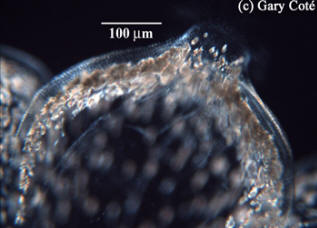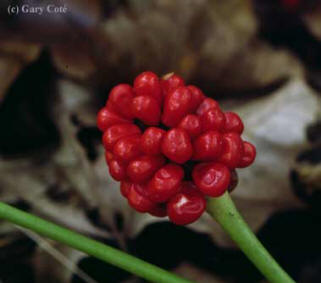Jack and Jill
When it comes to reproduction, the jack-in-the-pulpit has several options. It has the ability to reproduce asexually as well as sexually.
The plant's asexual means of reproduction involves the jack-in-the-pulpit's corm, which is an underground, bulblike stem. The corm produces "cormlets", underground buds which will form into new plants. Find out what else a corm is used for on the nutrition page!
The jack-in-the-pulpit uses a unique
method of sexual reproduction known as
sequential hermaphroditism. In this
mode, any given plant could
be male, female, or both. The
environment of each plant determines its
gender. For example, when things are
going well for the jack-in-the-pulpit and
the environmental conditions are right, a
plant is more likely to produce female
flowers. These flowers are not the spathe, which all jack-in-the-pulpits possess, but actually extremely small
flowers, which are located inside the spathe
at the base of the spadix. You can see
a picture of a female flower off to the right. Conversely, in
times of environmental stress, the
jack-in-the-pulpit will revert to its male
form in the following growing season.
Male flowers are located in the upper spadix
and are much smaller than their female
counterparts. A picture of some male
flowers is below.
The pictures on this page and several others were provided by Wildwood Park web
manager Gary Cote. To
see their home page, click
here
or to view their Species of the Week page on
Arisaema triphyllum, click any of
the pictures.
possess, but actually extremely small
flowers, which are located inside the spathe
at the base of the spadix. You can see
a picture of a female flower off to the right. Conversely, in
times of environmental stress, the
jack-in-the-pulpit will revert to its male
form in the following growing season.
Male flowers are located in the upper spadix
and are much smaller than their female
counterparts. A picture of some male
flowers is below.
The pictures on this page and several others were provided by Wildwood Park web
manager Gary Cote. To
see their home page, click
here
or to view their Species of the Week page on
Arisaema triphyllum, click any of
the pictures.
Female jack-in-the-pulpits produce fruits, so it takes more energy to be female rather than male. This is why stressed plants will revert to the male form. In times of extreme need, a plant may even change into a vegetative state. This vegetative state is used by the plant for the first four to six years of its life. This form of the plant cannot create male or female flowers and therefore cannot reproduce. While this does seem counterproductive at first, the use of sequential hermaphroditism does have its benefits. It secures that only plants that are large enough and in "good enough condition" are able to reproduce. Sequential hermaphroditism also inhibits self-fertilization.
Jack-in-the-pulpits flower during the
early part of summer and the fruits are
produced later in the summer. The
berries are attached to the stalk of the
spadix where the female flowers had been.
They begin green in color, but by autumn,
they become bright red.  The fruits are
actually the plant's ovaries and can carry
up to six ovules. The ovules hold the
seeds themselves, but often contain only one
or two seeds. The low number of seeds
produced causes the jack-in-the-pulpit to
have a slow distribution rate.
The fruits are
actually the plant's ovaries and can carry
up to six ovules. The ovules hold the
seeds themselves, but often contain only one
or two seeds. The low number of seeds
produced causes the jack-in-the-pulpit to
have a slow distribution rate.
The jack-in-the-pulpit's reproductive cycle isn't the only interesting thing about it. Head over to the interesting facts page to learn more!
